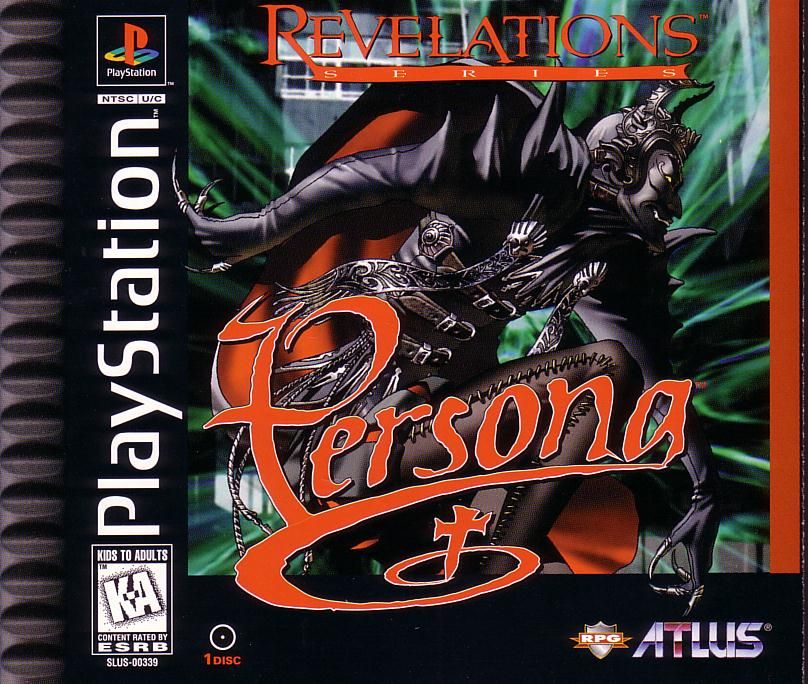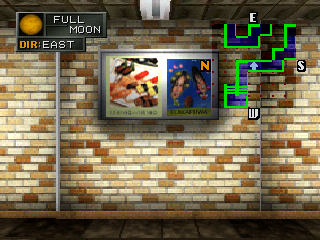Retro Replay Review
Gameplay
Persona’s gameplay hinges on a compelling blend of traditional JRPG exploration and innovative social mechanics. Players navigate an overworld rendered in an isometric view, visiting familiar locales like school corridors and the hospital. When venturing into dungeons, the perspective shifts to a first-person 3D view, transforming routine strolls into tense, maze-like treks. This duality keeps exploration fresh, as you toggle between everyday life and the twisted otherworld infested by demons.
(HEY YOU!! We hope you enjoy! We try not to run ads. So basically, this is a very expensive hobby running this site. Please consider joining us for updates, forums, and more. Network w/ us to make some cash or friends while retro gaming, and you can win some free retro games for posting. Okay, carry on 👍)
Combat unfolds through random encounters, pitting your high-school party—armed with melee weapons, firearms, and magic—against various fiends. What sets Persona apart is its demon communication system: each character wields four distinct negotiation styles (for instance, flattery or provocation), and your choices, combined with the current moon phase, dictate a demon’s reaction. Success can net you items or spell cards, while failure may force you to fight or flee. This layer of strategy rewards experimentation and adds depth to every run-in.
Between battles, the Velvet Room beckons as a hub for Persona fusion. By consuming spell cards earned through negotiations, you can merge weaker Personae into more powerful entities. Attaching these to characters alters their statistics, inflicts new elemental strengths or vulnerabilities, and unlocks fresh spells. Managing this fusion system becomes a satisfying puzzle: balancing versatility against raw power, and tailoring Personae to counter specific demon types.
Graphics
On a technical level, Persona’s visuals are unmistakably rooted in the mid-’90s PlayStation era. Overworld segments feature detailed pixel art, with small sprites conveying personality through subtle animations. Dive into dungeons, and you’re greeted by stark 3D corridors with minimalist textures—every twist and turn feels ominous as shadows dance across stone walls.
Despite hardware limitations, the art direction shines in creature design. Demons range from grotesque to elegant, each model reflecting mythological influences filtered through a distinctly modern lens. Cutscenes and dialogue portraits further bolster immersion: character expressions shift dynamically, hinting at inner turmoil or resolve. The UI complements this aesthetic, with sleek menus and thematic color schemes that reinforce the game’s moody atmosphere.
While polygon counts and resolution may feel dated to contemporary eyes, Persona compensates with style. The contrast between bright, everyday school scenes and the warped, demon-ridden world underscores the narrative’s duality. If you approach the graphics as a period piece rather than a current-gen benchmark, you’ll appreciate the game’s visual identity and its ability to evoke unease and wonder in equal measure.
Story
Persona opens with a straightforward premise: a group of high-school students dabble in a ritual “game” and find themselves gifted with the power to summon Personae by Philemon, a mysterious guiding entity. Their first mission—to visit a hospitalized friend named Mary—quickly unravels into something far more sinister. Upon leaving the room, they discover their hometown transformed, sealed off from the world and overrun by malevolent forces.
The narrative weaves corporate intrigue, as Sebec Corporation appears to be the architect of this catastrophe, with its cold manager pulling the strings. Yet the game never stops there: as demons loom in every alley, the true conflict emerges from within. Each protagonist must confront their own insecurities, guilt, and unspoken fears. This psychological undercurrent elevates the story beyond mere monster-slaying; it becomes an introspective journey where self-acceptance is as crucial as combat prowess.
Dialogue is rich with character interactions, balancing moments of levity—teens joking in the schoolyard—with tense confrontations in demon-infested corridors. The branching nature of demon negotiations and Persona fusion subtly mirrors these themes: forging alliances through empathy or overpowering obstacles with force. Even if the overarching plot occasionally leans on JRPG tropes, Persona’s emphasis on inner truth and personal growth lends it a unique, memorable voice.
Overall Experience
Playing Persona feels like straddling two worlds: the familiar routines of high-school life and the perilous depths of a demon-haunted realm. This duality keeps the pace engaging, alternating between social interactions—where you might chat with classmates or shop for supplies—and high-stakes dungeon delves. The interplay ensures you’re never stuck in one gear for too long, maintaining a steady rhythm that drives you forward.
Difficulty wise, Persona offers a fair challenge. Random encounters can be punishing if you neglect party composition or ignore demon negotiations. However, the satisfaction of landing a perfect negotiation to score rare spell cards, then fusing a powerhouse Persona, makes every tactical decision feel meaningful. The learning curve around moon phases and communication styles rewards patient experimentation rather than punishing newcomers outright.
Ultimately, Persona stands as a landmark in the Megami Tensei franchise and the JRPG genre at large. Its marriage of turn-based combat, demon diplomacy, and character-driven storytelling laid the groundwork for future entries. While its graphics and user interface show their age, the core design remains robust and engaging. For players seeking a thoughtful RPG experience that combines supernatural intrigue with emotional depth, Persona remains a must-try classic.
 Retro Replay Retro Replay gaming reviews, news, emulation, geek stuff and more!
Retro Replay Retro Replay gaming reviews, news, emulation, geek stuff and more!









Reviews
There are no reviews yet.